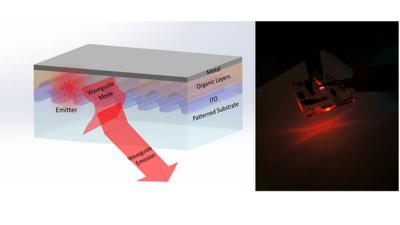Researchers from North Carolina State University and the University of Texas have developed and demonstrated a new approach for designing photonic devices. The new method enabled the team to control the direction and polarization of light from thin-film LEDs, overcoming the widely known obstacles of beam shaping that arise from their Lambertian nature. Such LEDs with directional and polarized light emission could be useful for many photonic applications.

'This is a fundamentally new device architecture for photonic devices,' says Franky So, corresponding author of a paper describing the work and Professor of Materials Science and Engineering at NC State. 'And we've demonstrated that, using our approach, directional and polarized emissions from an organic LED or a perovskite LED without external optical elements can be realized'.
The highly selective diffraction of only the TE waveguide mode was possible due to the planarization of the device stack by thermal evaporation and solution processing. Using this strategy, directional and polarized emission from a perovskite LED having a current efficiency 2.6 times compared to the reference planar device was further demonstrated. This large enhancement in efficiency in the PeLED is attributed to a larger contribution from the TE waveguide mode resulting from the high refractive index in perovskite materials.
Such an approach that allows for directional control of light using thin-film LEDs would, for example, enable the development of VR and AR headsets that are substantially lighter, less bulky, and with improved efficiency.
For AR units, it also means that more light from the outside world gets through to the user. In other words, the user will still be able to see the image being superimposed on his view of the real world, and the view of the real world will be clearer.
'Because the device we've demonstrated is simple to fabricate and can be easily scaled-up, our discovery of this strong directional and polarized light emission from OLEDs and perovskite LEDs has important applications for displays, lighting and other photonic applications,' So says.